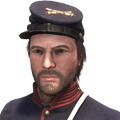Dear Developers, I’ve been a fan of some of your previous Civil War projects, and I have been looking forward to this game. I think you guys have done an amazing job recreating battlefields, and implementing game mechanics. I was also excited to see you guys were going to make this game with historical accuracy in mind. I don’t want anyone to read this and think the purpose of me posting this is to be a hater or anything like that, and I’m not trying to suggest another random game mechanic to add to the game like most posts on this thread. I am genuinely curious about the direction this game is going to take to accurately recreate the Maryland campaign of 1862.
Before I made an account on this forum I was reading through the suggestions page and in between all of these posts asking for a John Brown Simulator 2016, and ironclad warfare, etc there was a good post made which brought up the fact that the 20th Maine didn’t fight at Antietam. The Op asked why the 20th Maine is a unit people can fight in skirmishes as. I thought the explanation from Hinkel explaining that this game is currently just focused on a drill camp scenario so any unit from the Maryland Campaign can be added…BUT that the 20th Maine will not be in any Antietam skirmish battles was fitting.
This leads me to my first question which is: Why is there a company being formed under the company tab of this forum as Wheat’s 1st Special Battalion? I am confused because Wheats 1st Special Battalion did not exist as a unit by the time of the Maryland Campaign so to have it be a part of the drill camp is contradictory to Hinkels original statement regarding units not involved in the Maryland Campaign. Also, why can this unit be a part of Skirmishes because again it didn’t exist by Antietam or any other battle of this campaign. (*NOTE* I am assuming this unit can be a part of skirmishes because on the page of the company that’s already formed they are talking about fighting battles). This Battalion fought at Bull Run, in the Shenandoah Valley campaign, and in the Peninsula Campaign until their commander Wheat and most of the Battalion was killed at Gaines Mill. Then the unit was disbanded and any survivors were split up and distributed throughout Hays LA Brigade way before the Maryland Campaign. On top of them not being a unit that was there for the campaign you guys have designed them all looking like their second company the Tiger Rifles as they before Bull Run. Besides the fact that each company had their own unique uniform at Bull Run not just the Tiger Uniform, the entire battalion discarded their unique uniforms prior to Jackson's Shenandoah Campaign before the Peninsula Campaign in exchange for LA state issue uniforms. Any survivors of the battalion would still be wearing LA state issue gear along with the rest of Hays Brigade at the time of the Maryland Campaign. I am just a little confused as to why the 20th Maine is restricted to drill camps but the 1st Special Battalion can be in drill camps AND fight battles even though their unit did not exist for months leading up to the Maryland Campaign.
This ties into my next question: I understand that with a very small developer team things take time but are there plans to take the current models for Confederate units and make them accurately represent the way the soldiers of the ANV appeared during the Maryland Campaign? I ask this because you have these awesome skins for units like the 4th Texas, 9th LA, etc but they all look as though they have come straight from a car wash. Obviously, there were exceptions to this rule but as a general theme the Confederates going into the Maryland Campaign were as rugged as they had ever looked. (In comparison, the ANV in 64 into 65 prior to the Appomattox Campaign were in general better equipped than they were marching into Maryland in 62). The Texans of Hoods Brigade for example were issued decent gear in 1861 including a unique “Texas” Frock Coat but by Antietam nothing was left of those uniforms and anything they were wearing were in shreds and full of filth. Civilian clothing purchased before or during the campaign and captured federal gear would have been the only gear in decent shape. The 9th LA (Coppens Zouaves) along with the rest of Hays Brigade is another example of this. They were wearing ragged LA state issue gear by the time the Battle of Antietam occurred…not clean examples of LA gear and especially not their unique Zouave gear that they wore at Bull Run. Like the Texans and every other unit in the ANV these uniforms were in severe disrepair not brand new.
To anyone reading this thank you for taking the time to read. I would prefer if this thread would just be about the Dev. Team's thoughts about what I wrote/what their plans are regarding my questions. I would prefer if this thread didn’t turn into a back and forth argument between others and myself as far as if anything I said is wrong. I have no problem giving you documentation regarding Wheats Battalion disbanding after Gaines Mill/their uniform history, and about the general level of disrepair of ANV troops going into Maryland in 1862. Just private message me or email me whatever is more convenient for you. Everyone have a happy holiday!





 Reply With Quote
Reply With Quote







